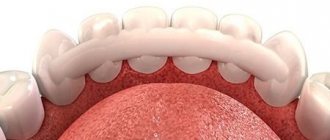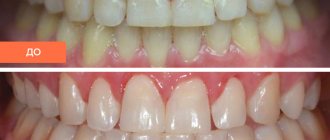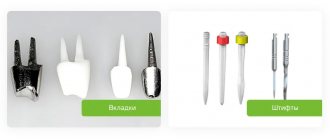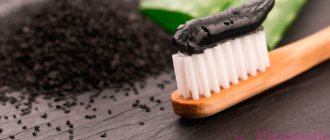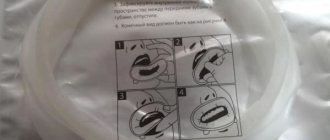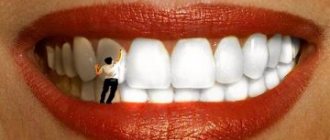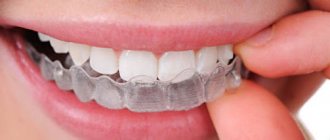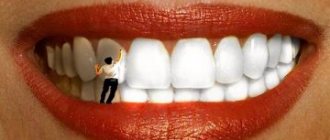Author of the article:
Soldatova Lyudmila Nikolaevna
Candidate of Medical Sciences, Professor of the Department of Clinical Dentistry of the St. Petersburg Medical and Social Institute, Chief Physician of the Alfa-Dent Dental Clinic, St. Petersburg
Today, there are many ways to whiten teeth in dentistry. Anyone who wants to get a delightful Hollywood smile will definitely find the most convenient and affordable option for themselves. You can change the color of your teeth a couple of shades to a healthy shade with professional cleaning, or you can achieve a snow-white smile with more serious cosmetic procedures. It all depends on your taste, desires and health. In any case, you can easily find the best method with the help of your dentist.
It must be remembered that whitening is a serious procedure that does not always have a positive effect on dental health. Therefore, it is important to take the choice of method and subsequent care seriously.
Let's talk about the differences, pros and cons of in-office whitening methods to help you navigate their diversity.
Advantages and disadvantages of the procedure
Positive sides:
- Quick results. In a single visit, you can noticeably lighten the enamel by several tones, the effect depends on its condition.
- No medical indications. The client of the dental clinic decides for himself whether he needs to whiten his teeth.
- Many methods with different effects and prices.
- No pain or other discomfort.
- Almost all methods are universal, which means they can be used for patients of different ages.
- There is no need to go through a recovery period.
- Getting rid of complexes and awkwardness when communicating with others.
The technique also has negative aspects:
- The most effective methods have a high cost.
- The effect does not last long. The smile will remain snow-white for 5-7 years, but no more.
- Increased sensitivity of enamel, its thinning. Pain may occur while eating if the food or water is too cold or too hot.
- Inability to change the color of filling material, implants, artificial crowns.
- The risk of losing the natural shade of teeth and excessive whiteness increases.
- The need to adhere to dietary nutrition to maintain results. It is not recommended to drink coffee, strong black tea, or eat foods with a high concentration of bright natural pigment.
How to remove stubborn plaque?
Abrasives
You can lighten your teeth using highly abrasive pastes. From 10% to 50% of the volume of such pastes is occupied by abrasives - hard polishing particles, with the help of which plaque and food debris are removed.
The cleaning and polishing properties of toothpaste depend on the concentration of abrasive particles, their size, shape and hardness. Silicon dioxide, calcium carbonate (chalk), sodium metaphosphate and even diamond dust are used as abrasives in pastes.
In dentistry, a single standard has been adopted for assessing the abrasiveness of hygiene products and their impact on enamel - the RDA (Relative Dentin Abrasivity) abrasivity index, where:
- 0–30 – low abrasiveness;
- 30–80 – moderate abrasiveness;
- 80–150 – high abrasiveness;
- >150 - polishing pastes for use no more than 1-2 times a week.
Pastes with high abrasiveness clean more intensively and are suitable for smokers and coffee lovers.
It is better to use such pastes in cycles or alternate with strengthening ones, otherwise you can injure the enamel. If you have sensitive teeth, chips and cracks in the enamel, highly abrasive toothpastes will not be suitable. Pastes with low and medium abrasiveness can be used every day. They often add additional bleaching agents - enzymes or peroxides.
Marvis Whitening Mint Toothpaste Whitening 85 ml
Toothpaste Apagard Smokin 100 ml
ApaCare Polish Polishing Toothpaste
ISME RasYan Herbal Clove Polishing Toothpaste
Enzymes
You can carefully and safely lighten enamel with pastes containing plant components - enzymes and extracts. They break down and loosen plaque, making it easier to remove. Such pastes have a low level of abrasiveness, which means they are safer for enamel. Enzymes are obtained from fruits: bromelain - from pineapple, papain - from papaya. You can brush your teeth with such pastes every day, even with sensitive enamel.
Yotuel Whitening Pharma toothpaste
Tooth cream SWISSDENT CRYSTAL (50 ml)
Toothpaste ROCS (ROCS) PRO Delicate whitening Sweet mint
Blanx Pro Pure White Toothpaste Pure white
Light
Lightening due to blue particles and pigments. Tooth enamel is able to absorb, reflect and scatter light, which affects its visible shade. Pastes containing blue particles, or pigments, create the optical illusion of whiteness. The blue undertone visually removes yellowness - this effect is used in detergents for white laundry. Such pastes give a short-term effect, because the pigments work only on the surface.
As a rule, pastes with pigments have a low or medium level of abrasiveness, since the emphasis is on the coloring effect. There are no contraindications for such pastes.
Blanx Pro Pure White Toothpaste Pure white
Blanx White Shock toothpaste 50 ml with activator lamp
Contraindications to teeth whitening
Doctors recommend completely abandoning the procedure or postponing it indefinitely during pregnancy and breastfeeding, as well as when:
- individual intolerance to the components of the whitening composition;
- the presence of a milk bite that has not changed to a permanent one;
- oncology;
- increased sensitivity of enamel;
- tissue damage due to traumatic exposure or other reasons;
- pulpitis in chronic form;
- orthodontic treatment;
- dental diseases (for example, caries) in the acute phase;
- a large number of fillings, fixed dentures, artificial crowns (possible color balance disturbances, unnatural whiteness of certain areas).
Each case is reviewed by a dentist; the doctor may prohibit lightening of the teeth to avoid adverse reactions. Why do you need teeth whitening if it will lead to irreversible consequences? It is likely that the presence of the above circumstances is not an absolute obstacle to a cosmetic procedure, and in the absence of dangerous risks it can be completed.
Preparatory stage
Isolation of teeth with rubber dam before whitening.
Before whitening, plaque must be removed. If this is not done, the whitening will be ineffective and uneven. In this case, this procedure was not required, since the girl takes care of her teeth and only a month ago came to us for preventive cleaning.
The technology involves the use of a special gel and an ultraviolet lamp. These factors have a negative effect on the mucous membrane, so it needs to be isolated. A special device is used for this, which you can see in the photo.
Now that the gums are well protected and the teeth are accessible, we can begin the main procedure. The patient's eyes are covered with glasses that protect the retina from the harmful effects of ultraviolet radiation.
How to reduce harmful effects
A dazzling smile does not mean that your teeth are completely healthy. Behind the thin enamel is dentin. It is a structure with yellowish or grayish pigmentation. Whitening uses active chemical compounds that lead to thinning of the enamel layer or damage to its integrity. This also affects the condition of the oral cavity.
To minimize negative consequences, the dentist performs the following actions:
- Conducts a visual inspection and assessment of the condition of hard and soft tissues in the mouth.
- Identifies possible contraindications.
- Selects a safe and effective method of teeth whitening.
- Uses any available methods to diagnose and relieve pathological processes.
A beautiful smile is the key to success!
The main wealth of a person at all times is his health.
And recently it has also become a criterion of well-being and wealth. Every day more and more people focus their attention on the condition of their teeth and the beauty of their smile, because this is a requirement of the time and one of the components of the image of a prosperous person. Thanks to the tireless work of dentists throughout our country and constantly flashing commercials on television, the value of healthy teeth, fortunately, has become clear to our people. Having left the panic fear of the dentist's office in the distant past, we are paying more and more attention to our teeth. Requirements have increased both for the quality of the treatment and the absence of pain, as well as for improving the aesthetic component of the result: the shape, color and naturalness of the teeth. Many patients complain about the dark color of their teeth, pigments and stains on the enamel that cannot be removed with toothpaste and a brush. It is not advisable to cover teeth with crowns or composite and ceramic veneers - veneers, since this requires removing a layer of enamel, that is, grinding the tooth. To solve the problem of teeth whitening, there are various techniques that we would like to introduce you to. the mechanical cleaning
method , which includes professional oral hygiene, and
the chemical whitening method
, which is based on the occurrence of oxidative processes that arise as a result of the action of atomic oxygen on the natural tissues of the teeth.
How to keep your teeth white longer
Depending on the technique used, the effect of professional whitening can last for more than one year. However, some patients return to the clinic after a few months for a repeat procedure. To ensure that your smile remains dazzling for a long time, doctors recommend adhering to the following rules:
- do not eat for 3 hours after teeth whitening, you can only drink clean water, then you must adhere to a special diet;
- Do not use a brush with hard bristles, as this will only increase sensitivity;
- purchase a paste without abrasive particles;
- rinse your mouth, use dental floss, and irrigator after each meal;
- Mouth rinses should not contain chlorhexidine (it stains teeth);
- follow a schedule of visits to the dentist for preventive examinations (at least once every six months);
- complete smoking cessation for 2-3 days, preferably for several weeks.
Special diet
To maintain the effect for a long time immediately after the procedure, you must adhere to a special diet. It is important to minimize the consumption of foods with bright colors. It is advisable to eat:
- porridge;
- dairy (but not fermented milk) products;
- fish and seafood;
- chicken, rabbit;
- egg white;
- white fruits and vegetables (such as bananas).
Along with eliminating food containing dyes from the diet, it is recommended to avoid coloring spices. This is turmeric, paprika. Dentists also do not advise eating smoked meats, citrus fruits, any berries, drinking coffee, black tea and alcoholic beverages.
“Making beauty” at home
Home whitening methods use individual dental trays for whitening gel, the concentration of which varies between 9-22%. Despite the fact that the home method is relatively slow and is carried out over 2-6 weeks (depending on the severity of the condition and some features of the structure of the tooth enamel, for example, with a disease such as fluorosis), the result is almost always wonderful. There is rarely any change in tooth sensitivity, which is quickly restored after the procedures are completed. Teeth, while lightening, retain the natural coloring of the entire surface and do not change their natural appearance. The desired effect is not always achieved only in teeth with tetracycline pigmentation and other types of color changes in the deep tissues of the teeth.
Types of teeth whitening: pros and cons
There are no ideal lightening methods. Each has positive and negative sides that the patient must be prepared for. This is why you need to consult your dentist first.
Mouthguards
These are removable devices that are made of special materials that are not subject to oxidative processes. As a rule, structures are used to correct bites and change the position of teeth. If the mouth guard is installed correctly, it does not cause discomfort (pain or other discomfort). After the adaptation period, the patient completely forgets about the presence of a foreign object in the mouth.
The device is created from an impression, which the dentist first makes during the initial appointment. The finished structure is filled with a whitening agent and placed on the upper or lower jaw.
Advantages:
- low cost compared to other methods;
- Possibility of teeth whitening at home.
Flaws:
- insufficient visual effect, mouth guards will not get rid of intense yellowish deposits;
- risk of developing an allergic reaction;
- The method is contraindicated for persons with orthodontic structures in the mouth (plates, braces, etc.).
Laser technique
This method is one of the most effective. You can walk with a snow-white smile for up to 10 years, of course, if you do not ignore medical instructions. In this case, the enamel becomes white in just one session.
A gel composition is applied to the teeth, after which its components are activated using a laser, oxygen ions are formed, which penetrate the enamel layer and deactivate the coloring pigment.
Pros:
- To lighten by more than 5 tones, one visit to the clinic is enough;
- absence of pain and other discomfort;
- the device operates for a short time (about 20 minutes);
- the gel used has antiseptic properties and prevents inflammatory processes in the mouth;
- the components of the drug strengthen the enamel and protect it from external influences.
Negative sides:
- high price compared to alternative methods;
- increased tooth sensitivity immediately after the procedure.
Ultrasonic cleaning
In this case, enamel lightening occurs due to the removal of hard plaque and other deposits, even in the interdental spaces. With the help of vibrations, all layers are mechanically removed. After all the manipulations, the specialist applies a special paste-like composition to the teeth to improve the protection of the dentition from external influences and various chemical irritants.
Ultrasound helps to get rid of even subgingival plaque. The stone is also removed.
Pros:
- in one visit to the dentist you can lighten your teeth several shades;
- during the procedure, the entire oral cavity is cleaned, and not just hard tissues;
- absence of pain and other unpleasant sensations;
- affordable price.
Minuses:
- To consolidate the effect, ultrasonic cleaning should be repeated annually;
- the result may seem insufficient if the enamel is too dark;
- the natural shade of dentin tissue does not change;
- A visit to the doctor takes up to an hour.
Chemical bleaching
The dentist applies highly concentrated preparations that contain hydrogen peroxide or other active ingredients. As a result, dentin is whitened, its shade becomes lighter by 5-7 tones or more.
Advantages of the method:
- an effective procedure that removes plaque and lightens the dentinal layer;
- if all manipulations were performed according to the rules, the result can last up to 4-5 years.
Minuses:
- increased sensitivity of enamel after lightening;
- high price;
- the risk of burns to the mucous membranes if the dosage regimen of the chemical composition is not followed;
- It takes many procedures (about 7) at intervals of 2-3 days to achieve the desired effect.
Air Flow
The surface of the teeth is processed mechanically, without affecting the dentinal layer. The doctor uses a sandblasting machine for this. Even the most difficult to reach areas (for example, interdental spaces) will be clean after exposure to a mixture of water, air and soda. The enamel is polished and the smile becomes dazzling.
Advantages:
- absence of pain and other discomfort;
- the entire oral cavity is cleansed, including the space between the teeth, under the gums, etc.;
- fabrics are not damaged, abrasive particles act very gently;
- the patient is not bothered by increased tooth sensitivity immediately after brushing;
- affordable price.
Minuses:
- insufficiently expressed visual effect;
- a greater number of contraindications compared to alternative methods;
- the color lasts up to a year.
Photobleaching
One of the most modern techniques with ZOOM or Luma-Arch devices. The enamel brightens due to ultraviolet exposure. The lamp warms up the lightening gel applied to the teeth, thereby enhancing its effect.
Pros:
- the procedure lasts about 15 minutes;
- per visit you can make the enamel 10 shades lighter;
- the effect lasts up to 4 years if you follow the rules established by your doctor and adhere to basic hygiene standards;
- absence of pain syndrome.
Minuses:
- high cost (methods involving mechanical cleansing will be much cheaper);
- It is advisable to completely exclude foods with bright dyes from the diet;
- subsequent remineralization may be required;
- before photobleaching, it is necessary to remove microprostheses and veneers;
- bleaching is uneven, hard-to-reach areas are not lightened, but only the front incisors and canines;
- If the procedure technique is not followed, the risk of burns to the mucous membranes of the oral cavity increases.
Endobleaching
This technique is also called in-canal bleaching. This method is used when depulpation has been performed, that is, removal of palpable tissue. After the death of the nerve, the teeth darken, so many patients want to lighten them.
The doctor pours a special synthetic composition with a whitening effect into the cavity and places a temporary filling material on top. If the enamel becomes lighter within 10-15 days, the drug is removed and everything is filled.
Advantages:
- you can lighten one or several teeth at once;
- the enamel remains intact because the whitening agent acts from the inside.
Flaws:
- short-term effect (up to a year);
- not suitable for processing both rows;
- the price increases as the number of teeth treated increases.
Home whitening
Not all patients want to visit a dental clinic and prefer to whiten their enamel at home. The most common procedures:
- The use of special whitening pastes. Typically, such compositions contain abrasives, affecting the entire surface of the dentition. As a result, it is possible to lighten the enamel layer by several tones.
- Special stripes. They resemble a plaster and are glued to the incisors of the upper and lower jaws. The adhesive side contains a gel with concentrated chemical compounds. An oxidation process takes place in the mouth, which promotes quick and easy cleansing.
- Traditional methods. Fans of “grandmother’s” recipes use hydrogen peroxide, soda, activated carbon and other substances.
What are the advantages of self-lightening at home:
- low price;
- ease of implementation.
The list of disadvantages is much more extensive than the list of advantages. This:
- low effectiveness compared to professional care;
- negative impact on enamel, damage to the mucous membranes of the oral cavity, the appearance of hypersensitivity to any irritant;
- high risk of allergies and poisoning due to careless use and, as a result, ingestion of bleaching mixtures.
Why are whitening pastes needed?
Does it follow from all of the above that whitening toothpastes are harmful and absolutely useless? Of course not. More precisely - not all. Some professional whitening toothpastes are able to maintain the effect of in-office whitening and cleaning due to the presence of hydroxyapatites - microelements that help restore enamel and prevent plaque formation.
Also, some whitening toothpastes can help heavy smokers, coffee lovers, lovers of strong tea and red wine - by dissolving a thin colored film and discoloring plaque. However, only your dentist can choose the right toothpaste for you. Such a paste, first of all, should not contain a large number of highly abrasive particles. You also need to remember that any whitening toothpastes are contraindicated for people with hypersthesia - increased sensitivity of teeth, children and adolescents with mixed dentition, as well as pregnant women.
Is teeth whitening worth it?
This is a very responsible procedure; if you make mistakes, you can start irreversible pathological processes. Doctors recommend dental cleanings twice a year to remove accumulated plaque. This is a superficial method that does not lighten the dentition. If a patient wants to whiten his teeth, he is indicated for professional whitening in dentistry.
Doctors do not recommend performing the procedure at home with store-bought pharmaceutical formulations. Firstly, it is very difficult to correctly calculate the dosage that will be safe for the enamel and for the entire body if accidentally swallowed. Secondly, even one careless action can lead to burns of the mucous membranes.
After lightening the enamel, you need to be prepared for sensitivity to temperature changes, sour, sweet, and solid foods. In addition, careful hygiene and diet will be required, which not everyone is ready for.
Having studied the indications and contraindications for professional cosmetic teeth whitening, the pros and cons of the procedure, you can choose a technique that is right for you. We invite you to sign up for a preliminary consultation with a Dentiki dentist by calling the number listed on the website or filling out the feedback form.
The essence of technology
The principle of operation of ZOOM 3 is as follows: a special gel containing calcium phosphate is applied to the teeth. Under the influence of the rays of an ultraviolet lamp, active oxygen is released, which is able to penetrate the thickness of the enamel and destroy pigments that negatively affect its shade. The gel contains calcium, which promotes mineralization and strengthens the enamel, so the procedure is not only not harmful, but, on the contrary, beneficial.
Free consultation on the cost of treatment in our dentistry
Leave a request and the clinic administrator will contact you within 15 minutes!
It is worth considering that any methods using chemicals have a number of limitations. You should not use whitening chemicals if there are units in your mouth with untreated caries, worn out and old fillings, old and hardened deposits, or inflammation of the soft tissues of the mouth. If there are such contraindications, it would be advisable to visit a specialist and, during a dentist appointment, carry out both high-quality sanitation of the oral cavity and the elimination of all problems that will interfere with the teeth whitening procedure.
Good to know: some modern teeth whitening pastes contain urea peroxide, and advertising assures that teeth will whiten simply by brushing them, since this component can not only erase dense plaque, but also lighten the pigments in the enamel coating itself. However, advertising and the manufacturer greatly exaggerate the effectiveness of such pastes.
They contain peroxide in low concentration, and therefore you should not count on a positive result in lightening the shade of enamel when using the paste. In addition, none of the lightening pastes contain acidic components, which make the enamel porous and thereby contribute to its rapid lightening. Therefore, we advise you not to waste your money and time and buy only those products for home procedures that your dentist recommends.
Free consultation on the cost of treatment in our dentistry
Leave a request and the clinic administrator will contact you within 15 minutes!
The essence of the procedure is that the specialist introduces a special bleaching substance into the dental canal, which causes an oxidation reaction and subsequent discoloration of the colored tooth tissue. After intracanal bleaching, the tooth becomes whiter, but in general, the results of the procedure will depend on the content of active substances in the gel and the time it remains in the canals. To get an aesthetic color and a beautiful smile, during intra-canal whitening it is recommended to visit the doctor strictly according to the established schedule, since if you leave the gel in the tooth too long, the tooth will become too light and will noticeably stand out from the rest.
The intracanal whitening procedure can hardly be called simple. It includes a number of stages. The process begins with the removal of old filling material from the canals, and then the dentist thoroughly cleans them with a specialized instrument - ideally thin taper drills. Next, the canals are treated with disinfectants and only after that a bleaching agent will be introduced into them.
Intra-canal whitening has not only indications for use, but also contraindications, including: childhood, periods of pregnancy and lactation, caries, periodontal inflammation, increased abrasion of the natural enamel coating, noticeable cracks in it. If we talk about the effectiveness and durability of the effect, then on average the results of intra-canal whitening last for a period of 2 to 3 years. If desired, the procedure can be repeated, but you should not abuse its quantity: the more times the chemical reagent is introduced into the tooth tissue, the more fragile they will become.
Before resorting to intra-canal teeth whitening, you should definitely consider the risks of possible undesirable consequences. In particular, after the procedure, dentin becomes more vulnerable to mechanical damage and destruction, and although the enamel will become lighter, it will not acquire a pleasant natural shine. It is difficult to choose the right chemical whitening method on your own, because it is important to take into account a number of nuances. Therefore, do not make a choice yourself - get advice from experienced and competent dentists at the Vanstom clinic! Our clinic is located next to the Baumanskaya metro station, you can make an appointment at any time convenient for you! The price of intra-canal whitening of 1 tooth at VENSTOM dentistry is 2,200 rubles.

